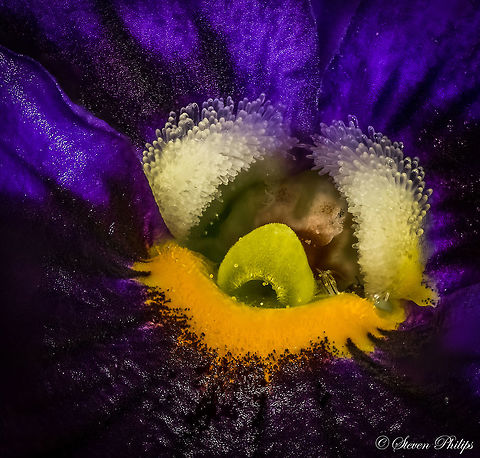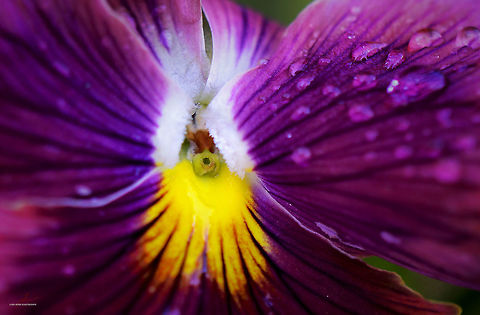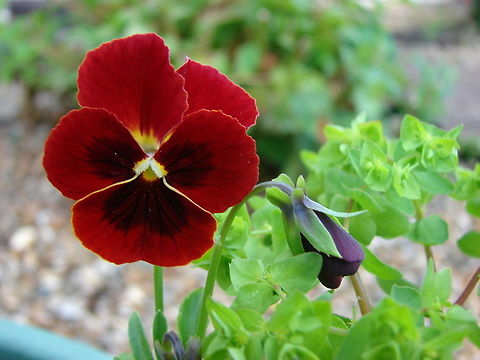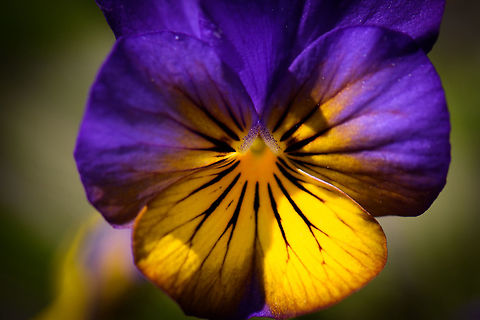
Appearance
The pansy flower is two to three inches in diameter and has two slightly overlapping upper petals, two side petals, and a single bottom petal with a slight beard emanating from the flower's center. The plant may grow to nine inches in height, and prefers sun to varying degrees and well-draining soils.
Naming
On account of its popularity in both society and its recurring appearances in Romantic poetry, a variety of new nicknames for the flower began to circulate. Dorothea Lynde Dix proclaims that “Perhaps no flower claims to be so universal a favorite, as the viola tricolor; none currently has been honored with so rich a variety of names, at once expressive of grace, delicacy and tenderness.” Many of these names play on the whimsical nature of love, including “Three Faces under a Hood,” “Flame Flower,” “Jump Up and Kiss Me,” “Flower of Jove,” and “Pink of my John.”In Scandinavia, Scotland, and German-speaking countries, the pansy is or was known as the Stepmother . This name rose out of stories about a selfish stepmother; the tale was told to children in various versions while the teller plucked off corresponding parts of the blossom to fit the plot.
In Italy the pansy is known as ''flammola'' , and in Hungary it is known as ''árvácska'' . In Israel, the pansy is known as the "Amnon v'Tamar", or Amnon and Tamar, after the biblical characters . In New York, pansies have been colloquially referred to as "football flowers" for reasons unknown. In some countries of Spanish language, the pansy is known as "Pensamiento" or "Trinitaria".
The name “heart’s-ease” came from the woman St. Euphrasia, whose name in Greek signifies cheerfulness of mind. The woman, who refused marriage and took the veil, was considered a pattern of humility, hence the name “humble violet”. The specific colors of the flower – purple, yellow, and white – are meant to symbolize memories, loving thoughts and souvenirs, respectively.
Another name for the pansy is that of “herb trinity,” with its three colorful petals acting as symbols for the Holy Trinity. The pansy’s connection to religion is also mentioned by Harte, who writes: “From brute beasts humility I learned;/And in the pansy’s life God’s providence discerned”. Gifford evokes both Christian and classical undertones, writing how “Pansies – still,/More blest than me, thus shall ye live/Your little day, - and when ye die,/Sweet flowers! The grateful muse/Shall give a verse”. Smart proposes “Were it not for thee, oh sun,/Those pansies, that reclining from the bank/View through the immaculate, pellucid stream,/Their portraiture in the inverted Heaven,/Might as well change their triple boast, the white,/The purple, and the gold”.
The name “Love in Idleness” was meant to imply the image of a lover who has little or no other employment than to think of his beloved one.
The name 'pansy' is derived from the French word ''pensée'' meaning "thought", and was so named because the flower resembles a human face; in August it nods forward as if deep in thought. Because of this the pansy has long been a symbol of Freethought and has been used in the literature of the American Secular Union. Humanists use it too, as the pansy's current appearance was developed from the Heartsease by two centuries of intentional crossbreeding of wild plant hybrids.
The Freedom From Religion Foundation uses the pansy symbol extensively in its lapel pins and literature. The flower has long been associated with human manner, as one man cleverly stated: “Nature sports as much with the colours of this little flower as she does with the features of the human countenance.” The pansy’s particular connection to human thought and emotion is mirrored in one Dr. Evan’s poems, where he captures the whimsical, yet deep emotional roots of the pansy’s symbolism: “Pied Pansy, - once a vestal fair/In Cerestrain, - now droops - /Stained by the bolt of love her purple breast,/And ‘freaked with jet’ her party-colored vest”. The shape of the petals, in particular its resemblance to the human face, it is not surprising that the pansy would come to be associated with deep contemplation. One man wrote in ''The Argosy'': “With its own symbolic meaning of thought, the pansy is also somewhat endued with a soft shadow, not necessarily of grief, but solemn and quiet, indeed grave, as thought should be.”

Cultural
The Pansy has figured in literature and the visual arts. In William Shakespeare's ''A Midsummer Night's Dream'', the juice of the heartsease is a love potion and "on sleeping eyelids laid, will make a man or woman madly dote upon the next live creature that it sees." . In ''Hamlet'', Ophelia distributes flowers with the remark, "There's pansies, that's for thoughts" . Other poets referencing the pansy include Ben Jonson, Bernard Barton, Michael Drayton, Edmund Spenser, William Wakefield, and William Wordsworth.Elsewhere in literature, Nathaniel Hawthorne published his last literary effort, an unfinished piece, entitled ''Pansie, a Fragment'', sometimes called ''Little Pansie, a fragment'' in 1864. D. H. Lawrence's ''Pansies: Poems by D. H. Lawrence'' was published in 1929, and Margaret Mitchell originally chose Pansy as the name of her ''Gone with the Wind'' heroine, but settled on Scarlett just before the book went into print. In the Harry Potter series, a character named Pansy Parkinson is a bully, and just one of the characters in the novels who has a flower related name, including Lavender Brown and Lily Potter.
In the visual arts, Pierre-Joseph Redouté painted ''Bouquet of Pansies'' in 1827, and, in 1874, Henri Fantin-Latour painted ''Still Life with Pansies''. In 1887, van Gogh painted ''Mand met viooltjes'', and, in 1926, Georgia O'Keeffe created a painting of a black pansy called simply, ''Pansy'' and followed it with ''White Pansy'' in 1927. J. J. Grandville created a fantasy flower called Pensée in his ''Fleurs Animées'', and the 1953 Disney animated film ''Alice in Wonderland'' featured a chorus of singing pansies in the Garden of Live Flowers scene.
The Pansy is a symbol of the Kappa Alpha Theta sorority,the Delta Delta Delta sorority and the Sigma Lambda Upsilon or Señoritas Latinas Unidas Sorority, Inc. The Pansy is the flower of Osaka, Japan, and was the name of the Epiphone Elitist Les Paul Custom guitar with an Alpine White finish played by guitarist Frank Iero of the band My Chemical Romance. Pansy was broken during a show.
References:
Some text fragments are auto parsed from Wikipedia.
